Between May 27th and June 10th 2023 I went on a family trip to Greece just to relax and explore, but of course also to look for wildlife.
The Mediterranean Monk Seal (MMS) is considered the world’s rarest pinniped species. The population of the species is estimated to be around 600–700 seals, of which 350–450 are considered mature individuals, distributed in three main areas. Two colonies are located in Atlantic waters, one in the Cabo Blanco Peninsula (Mauritania) with >360 seals, and a small one with an estimated number of 30–40 individuals in Madeira, Portugal. The third main area of distribution is concentrated in the North-eastern Mediterranean Sea (the Greek Ionian and the Aegean Seas, Cyprus and western and southern Turkey), where actively reproducing populations are known. Recent data indicate at least occasional presence of monk seals almost throughout the Mediterranean, even in countries where the species has been declared extinct. (G. Hernandez-Milian et al., 2023)
Legislative measures, research, management, and conservation actions designed to protect important monk seal habitat in the eastern Mediterranean Sea are currently in place in the following areas: the National Marine Park of Alonnisos – Northern Sporades Islands (150 km north of Athens), the marine protected area in Northern Karpathos – Saria (southwest of Rhodos) and the 3-mile no-take zone at the island of Gyaros (50 km southeast of Athens). (Karamanlidis, 2016).
In Turkey, conservation efforts focus on five coastal locations in the country: Foça, Karaburun, Alaçatı-Sigacik, the Bodrum Peninsula, and the Cilician coasts, although serious concerns have been raised about the efficacy of management and implementation (Karamanlidis, 2016).
I also checked sightings of MMS on mammalwatching.com and talked to a fellow biologist. Jonathan Ben Simon has seen Mediterranean Monk Seal near Lichadonisia Islands, two hours northwest of Athens in October 2022. Anita Ericson and Lars Petersson tried it in October 2021 for two days near Volos and the Pelion peninsula without luck. Mike Bailey was lucky to see MMS near Kamena Vourla in March 2018, which is basically opposite Lichadonisia Islands, mentioned above. Vladimir Dinets reports Zakynthos as a place to see MMS, while my friend Andi, a biologist, recommends neighbouring Kefalonia as THE place for MMS. (Post scriptum: There are many more sightings listed on wikipedia / english version.)

So we give the seals a try. As usual within Europe we avoid flights to relieve our carbon footprint and take our VW Bulli instead. Coming from Germany we embark the ferry in Ancona (Italy). We depart at 16:30 to reach Patras the next day around 15:00. The ferry‘s route leads through a channel between the islands of Lefkada and Kefalonia (while Zakynthos is located south of Kefalonia). I concentrate on scanning this region in particular on the way in, but do not detect any marine mammals.

We stop at Delphi to ask the oracle what I should do when my daughter turns 18 in September this year (which will give me more time). I force the oracle a little bit – as Alexander the Great did, when he was here and asked if he should conquer the world. The oracle tells me I should go traveling the world …

We find a Marginated Tortoise (Testudo marginata) – Breitrandschildkröte – and numerous Western Rock Nuthatches (Sitta neumayer) – Felsenkleiber.
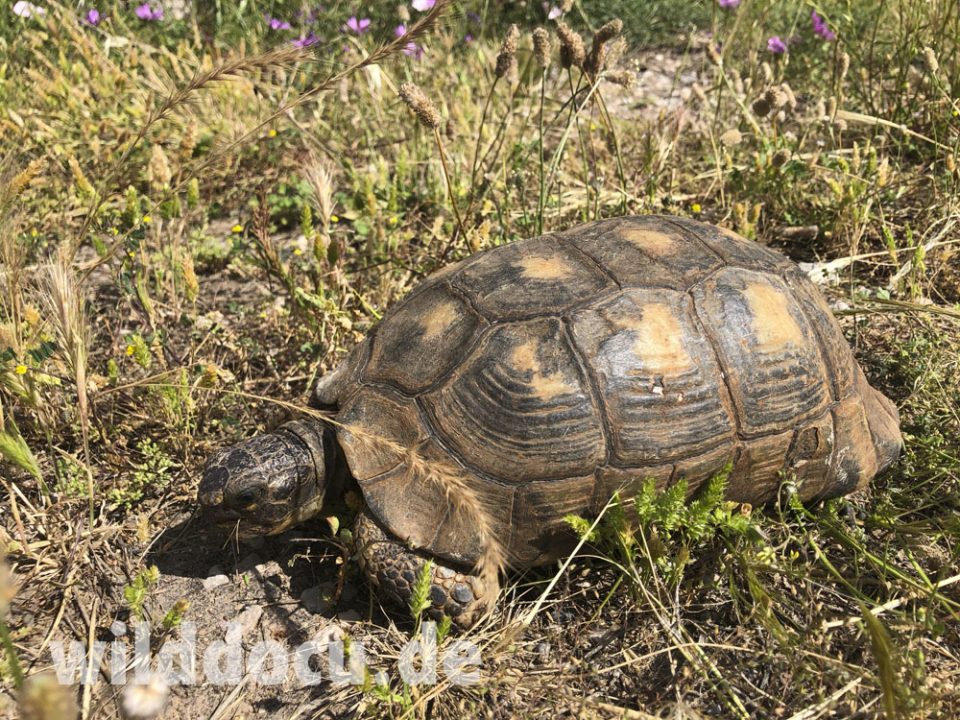
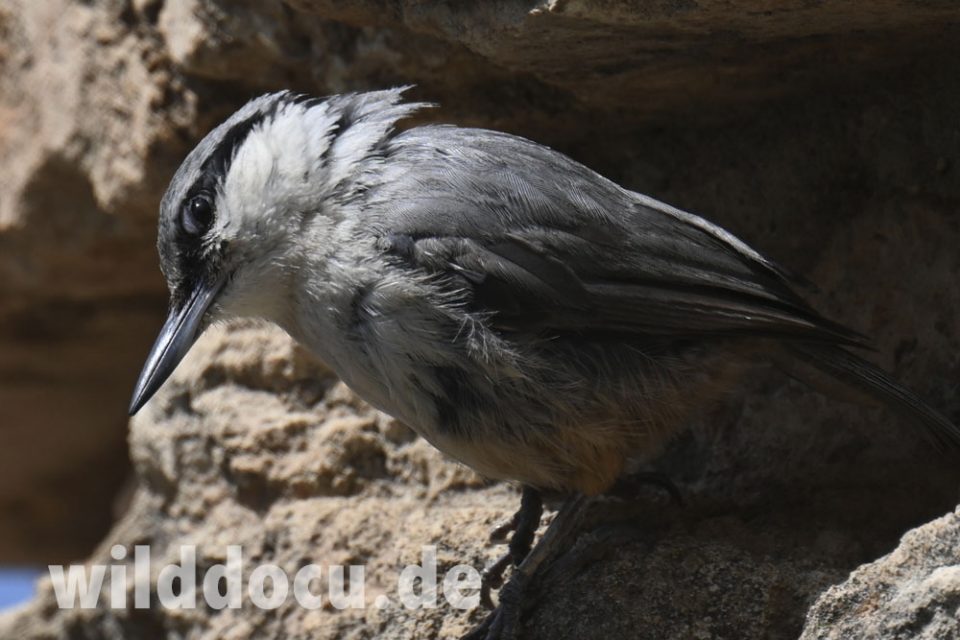
We reach the city of Volos and the Pelion peninsula, which really impresses me:
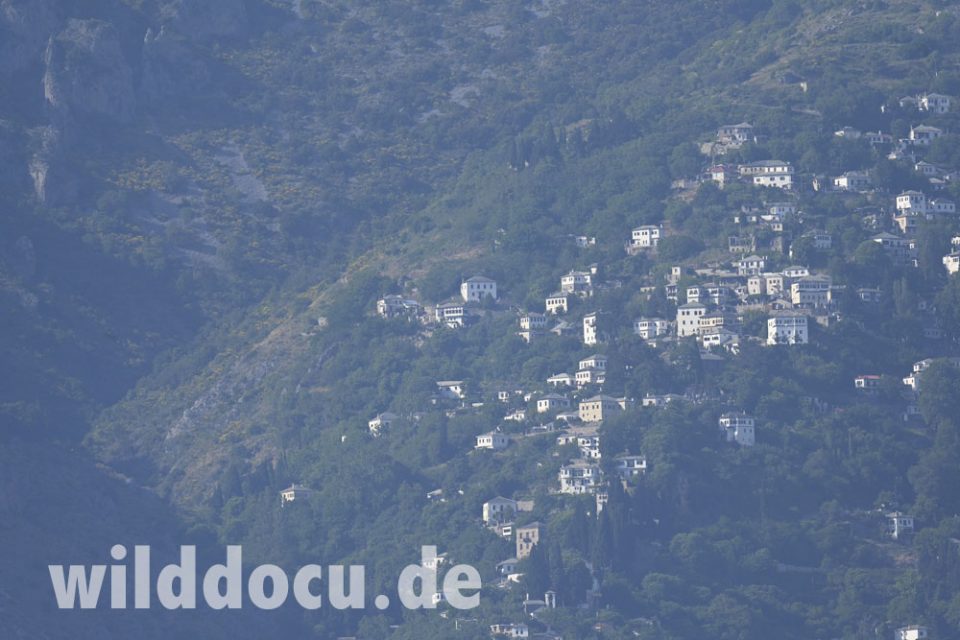
This peninsula seems to be a very promising area for mammal watchers. Its highest summit, Pourianos Stavros, is 1.624 metres. The mountain is thickly forested, mainly of chestnut trees and beech (higher up). Pelion is an amply watered mountain with an abundance of springs, streams and gorges. Many creeks are routed in artificial beds to bring water to the villages and their orchards. The higher elevations receive enough snowfall so as to host skiing facilities. And there are great beaches too.
While sitting in a restaurant near Mouresi (west coast of the Pelion peninsula) we see the first cetacean of the trip. But it’s too far to identify the species. (Maybe with less beer the picture would have been more clear.)

During an early morning walk I leave the houses behind and reach a wonderful grove of old chestnut trees.
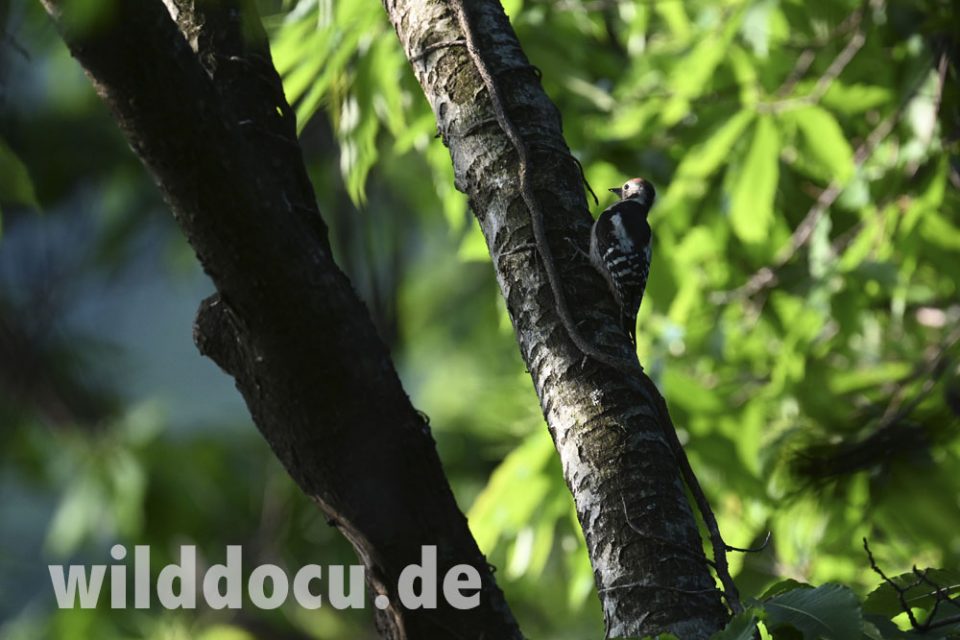
I find a Eurasian Red Squirrel (Sciurus vulgaris) – dark morph – and see a marten for a split second. I can’t be sure, but get the impression that it is a European Pine Marten (Martes martes) – Baummarder. A mouse in my thermal scope is probably an Apodemus species. Spare wheel covers on cars depict Wild Boars (usually these kinds of animal figures are related with hunters). This gives a hint that this species is present in the area too.
A day at Paralia Fakistra Beach presents us a closeup look of a fantastic Sheltopusik (Pseudopus apodus) – Scheltopusik oder Panzerschleiche –, the world’s largest Anguinae, reaching 1,4 metres. Birds of the day are a couple of Blue Rock Thrush (Monticola solitarius) – Blaumerle – and Alpine Swifts (Tachymarptis melba) – Alpensegler.


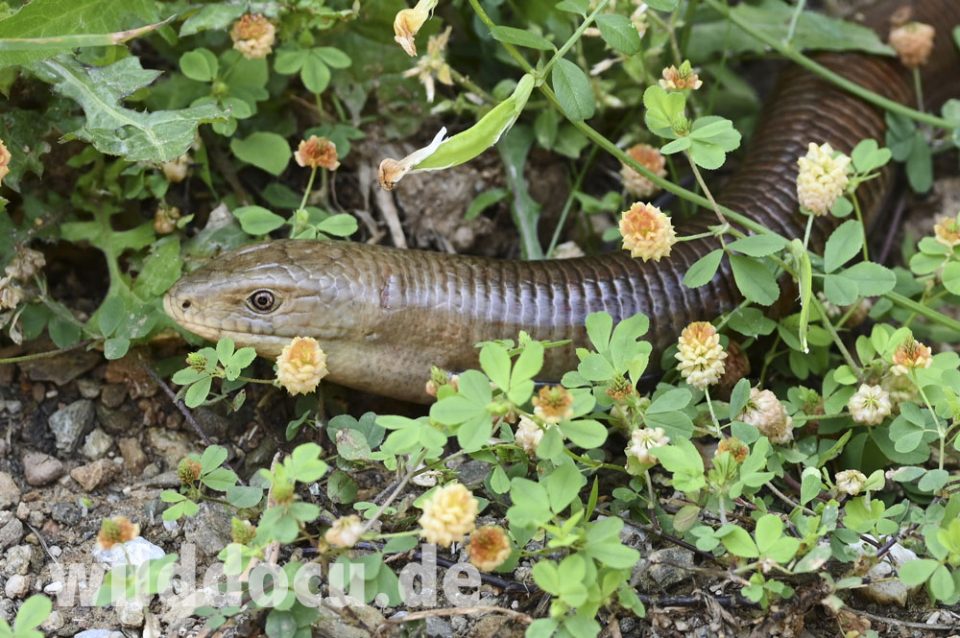

We drive back to Volos and take the ferry to Alonnisos. The route leads you through the Pagasetic Gulf, around the Pelion peninsula, to the island of Skiathos, Skopelos and finally Alonnisos – all of these waters should be good for Mediterranean Monk Seals. But we don’t see any.
During the crossing from Skiathos to Skopelos we detect our first Common Dolphins (Delphinus delphis) – Gemeiner Delfin –, a couple that gives us a great show.
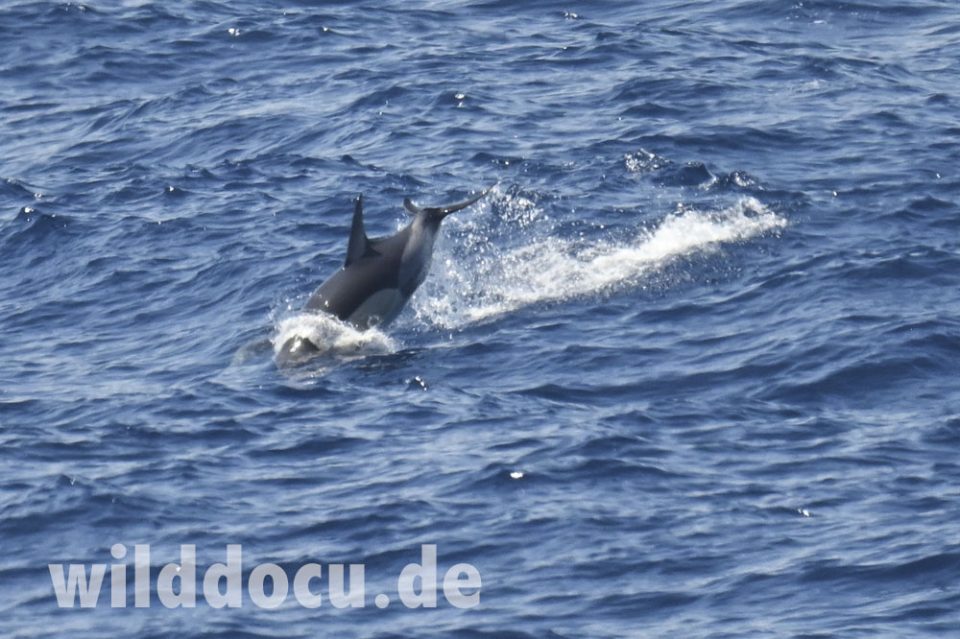
There is also a Loggerhead Sea Turtle (Caretta caretta) – Unechte Karettschildkröte – floating by, sadly dead.

The first days on Alonnisos we stay at Camping Rocks the only campground on the island. This early in the season we are the only guests. The next morning, during my gymnastic exercises on the beach, I observe two dolphins in the stern wave of an “Aegean Flying Dolphins” ferry. Again the conditions are too bad to be sure if they are Common Dolphins or Bottlenose Dolphins. And Striped Dolpins, Harbour Porpoises and Risso’s Dolphins are again other possibilities in these waters. From a distance I see a rat crossing the road, but not very clearly. It could be a Black Rat, which are famous for many Mediterranean Islands. My bat detector indicates Common Pipistrelle (Pipistrellus pipistrellus) and Common Noctule (Nyctalus noctula).
The main town on Alonnisos is Patitiri. In the harbour area you find a Monk Seal Information Center managed by The Hellenic Society for the Study and Protection of the Monk seal (MOm) with a little, but very informative exhibition concerning this species as well as other animals from the surrounding National Marine Park.
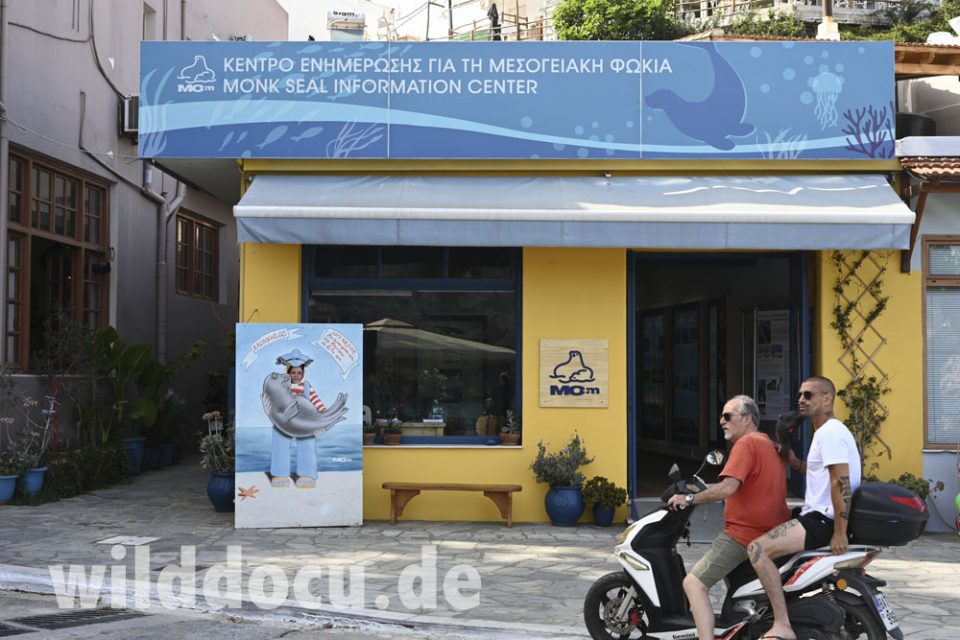


We visit Old Patitiri, the former chief village of the island, which was destroyed by an earthquake in the 1960ies. Today most of the buildings are restored.
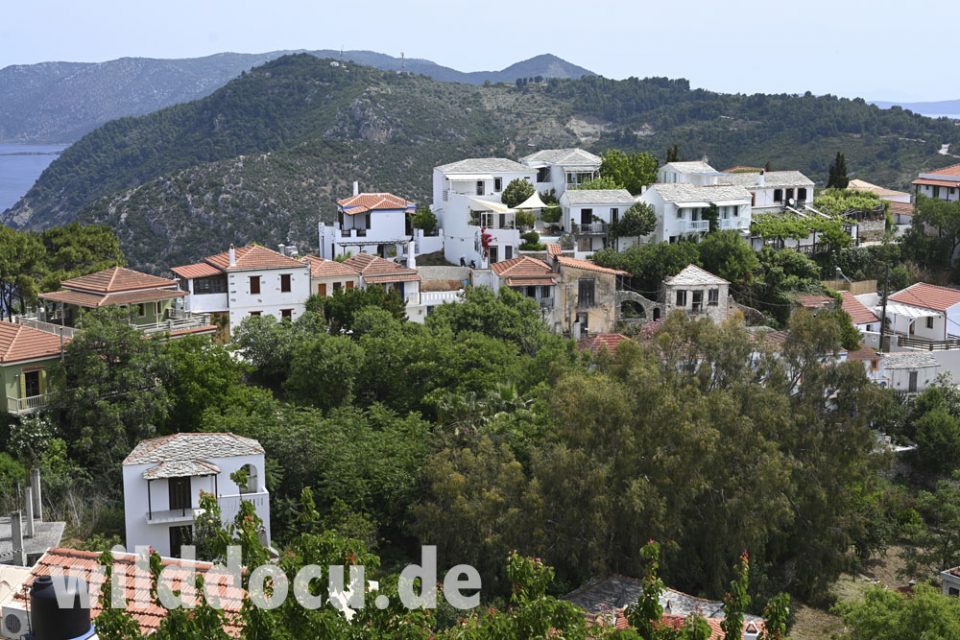

I find a scat of a Stone Marten (Martes foina) – Steinmarder –, numerous Erhard’s Wall Lizards (Podarcis erhardii) – Ägäische Mauereidechse – and many souvenirs depicting Mediterranean Monk Seals.
We visit many wonderful beaches, but don’t get to see any seals. So let me ask the maybe silly appearing question: Does it make sense to wait for a seal to come by? According to Wikipedia Greece has 13.676 kilometres of coastline and about 250 MMS. Assuming that MMS stay close to the shore (which is true in terms of feeding and pupping), that the average group size is 10 (I found one figure saying that they build herds of up to 20, but many observers mention just one individual) and neglecting that they do travel (one record of a maximum straight distance travelled: ∼78km -Karamanlidis, 2016), this roughly means that you find a group of seals in Greek waters every 500 kilometres . So better go searching for it!


We spend a day with captain Pakis Athanasiou on his ship Gorgona. His route usually follows the southeast coast of Alonnisos to reach the island of Kira Panagia. Because of rough seas we do not reach this island, instead we follow the west coast of Peristera to the south. Again these waters should harbour monk seals, but we don’t find any. While the MOm writes that the numbers of MMS are increasing, Pakis says he hasn’t seen them the last two years. He also mentions that chances to see them are higher in the water compared to sightings on beaches.
East of Kira Panagia lies another exciting island: Gioura (also spelled Youra), one of the easternmost islands of the Northern Sporades. Not only is it a retreat for the seals. It also harbours a population of the Cretan Wild Goat. According to Pakis there is no access for the public at the moment. Ships have to stay 500 metres off the coast, but hunters go there in autumn. Find more details about the Gioura Goat in my Cretan Wild Goat chapter.

We make a day trip from Alonnisos to Skopelos with the already mentioned high speed ferry “Aegean Flying Dolphins”. Although I do not recommend this kind of ferry for sea life observations (too fast, too loud, too stinky), it is actually possible to scan the surface of the sea in the open in the back of the boat. If you detected a seal in the water however, it would be vanished in a split second, but some Yelkouan Shearwater (Puffinus yelkouan) – Mittelmeer-Sturmtaucher –, which are able to keep pace with the ferry, are easily observed through the glass-free window of the ship.
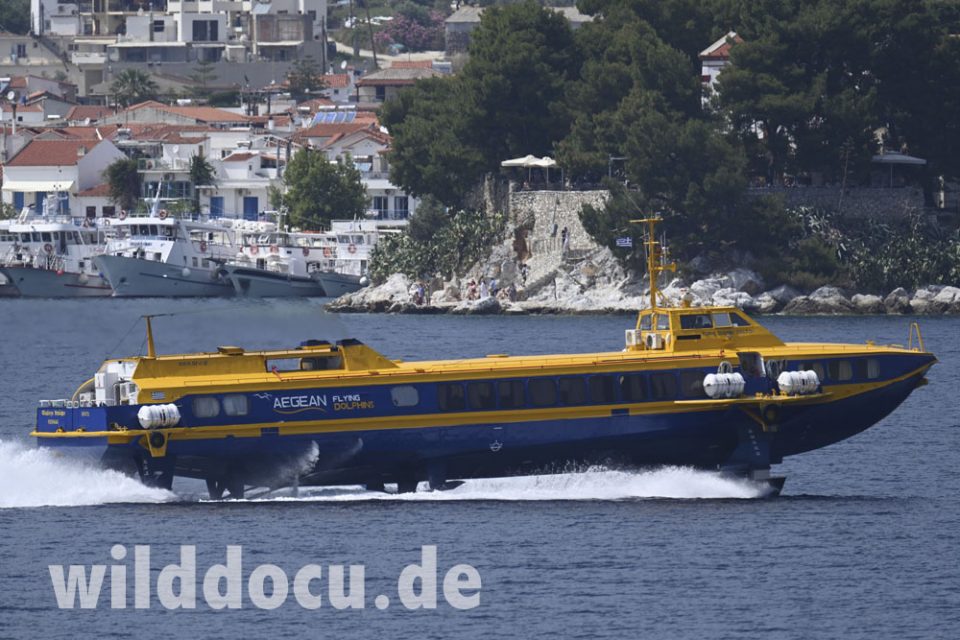
But your best bet to see MMS is probably to go with the type of ferry that operates between the mainland and the Sporades. It is reasonably fast to cover a relatively huge area, but not too fast. You have the opportunity to stand on the ship’s bow scanning both sides of the ship. You are high above the sea level to look far, but not too high to only see an animal in an unfavourable angle. We use this ferry again on the way back.
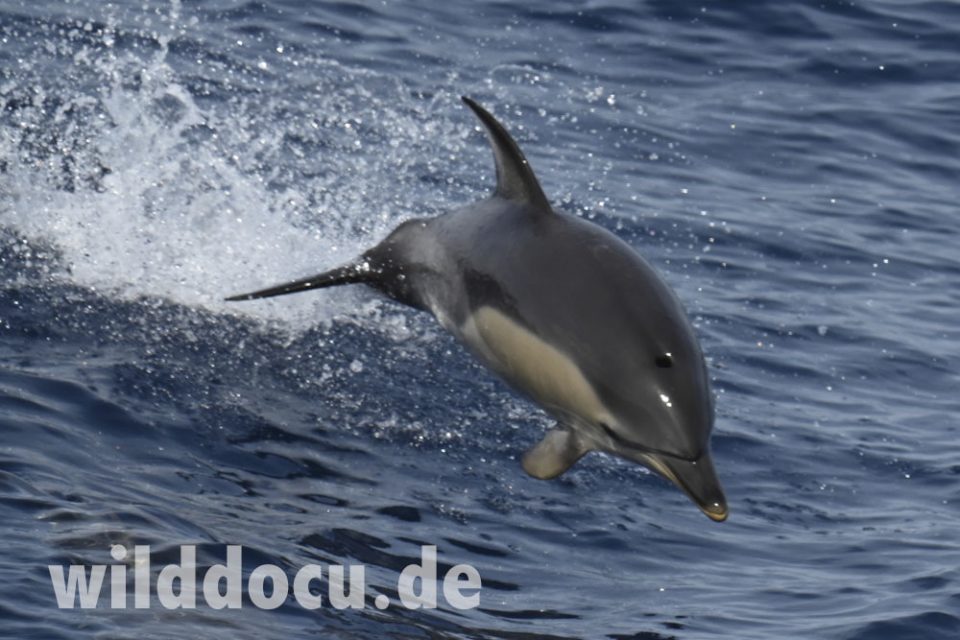

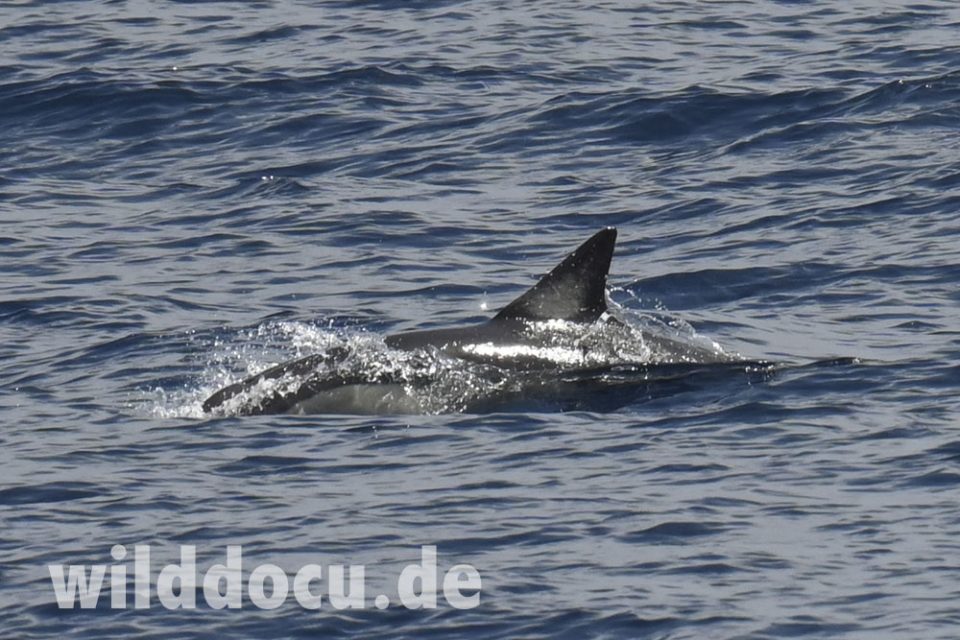
Just before reaching the harbour of Skiathos we have another encounter with more Common Dolphins (4-5) and again, when we leave the port. Yelkouan Shearwater (Puffinus yelkouan) – Mittelmeer-Sturmtaucher – and Scopoli’s Shearwater (Calonectris diomedea) – Sepiasturmtaucher – are other welcoming attractions.
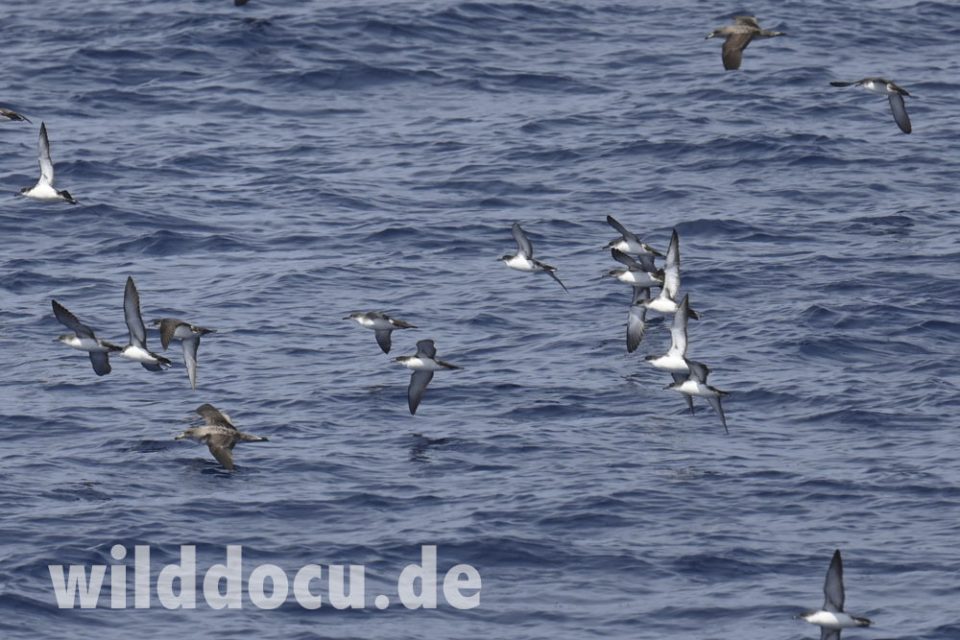
Scopoli’s Shearwater (Calonectris diomedea) – Sepiasturmtaucher: the bigger, more brownish ones
Later on the last ferry ride between Patras and Ancona, still in the Gulf of Patras (or just outside), I see a pair of Common Bottlenose Dolphins (Tursiops truncatus) – Großer Tümmler.
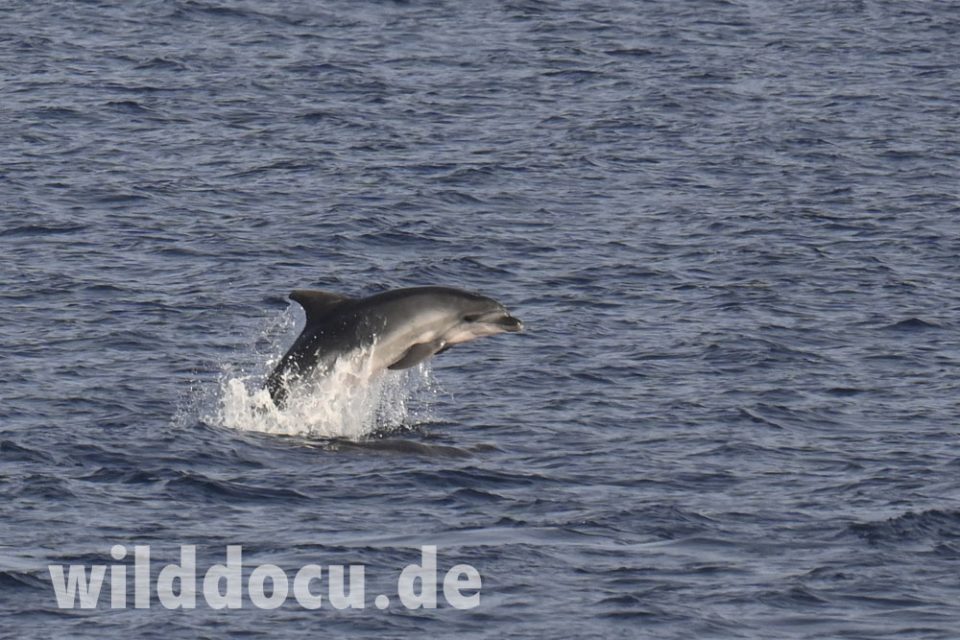
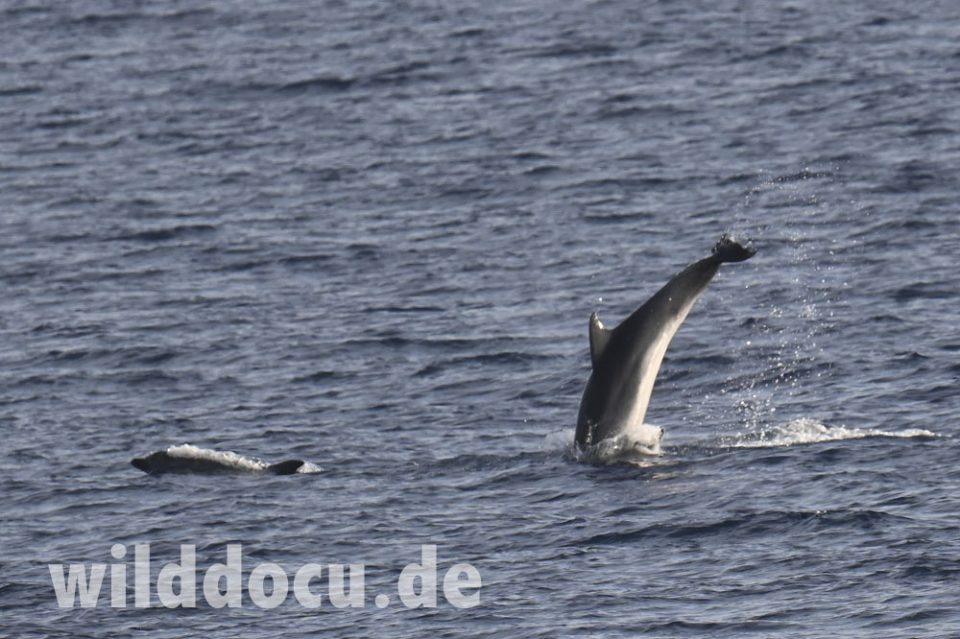
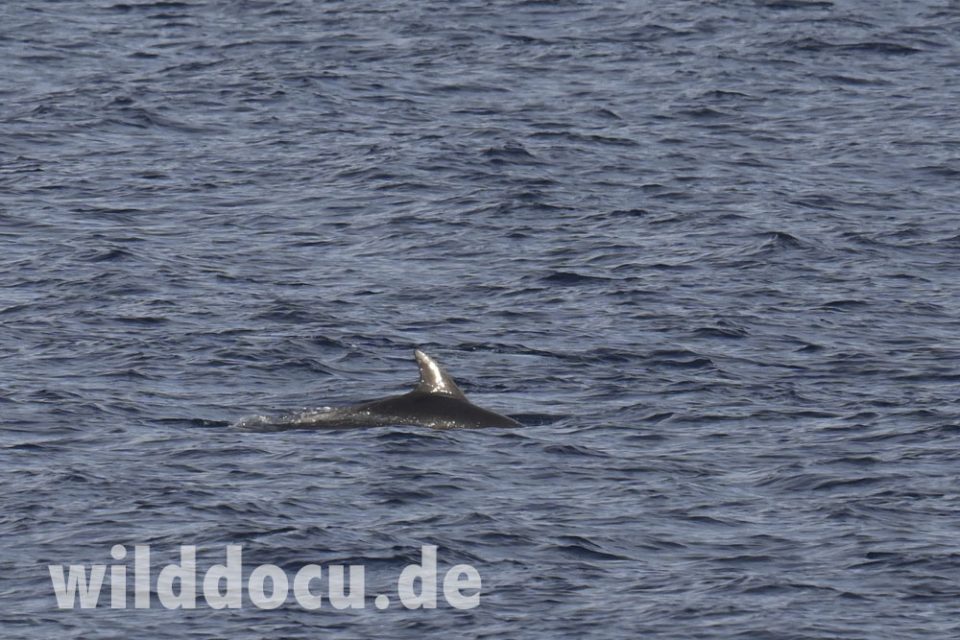
Sandwich Tern (Thalasseus sandvicensis) – Brandseeschwalbe – and Common Tern (Sterna hirundo) – Flussseeschwalbe – are some of the last avian goodies of this trip. But the absolut highlight is the opportunity to photograph closeups of Scopoli’s Shearwaters (Calonectris diomedea) – Sepiasturmtaucher.


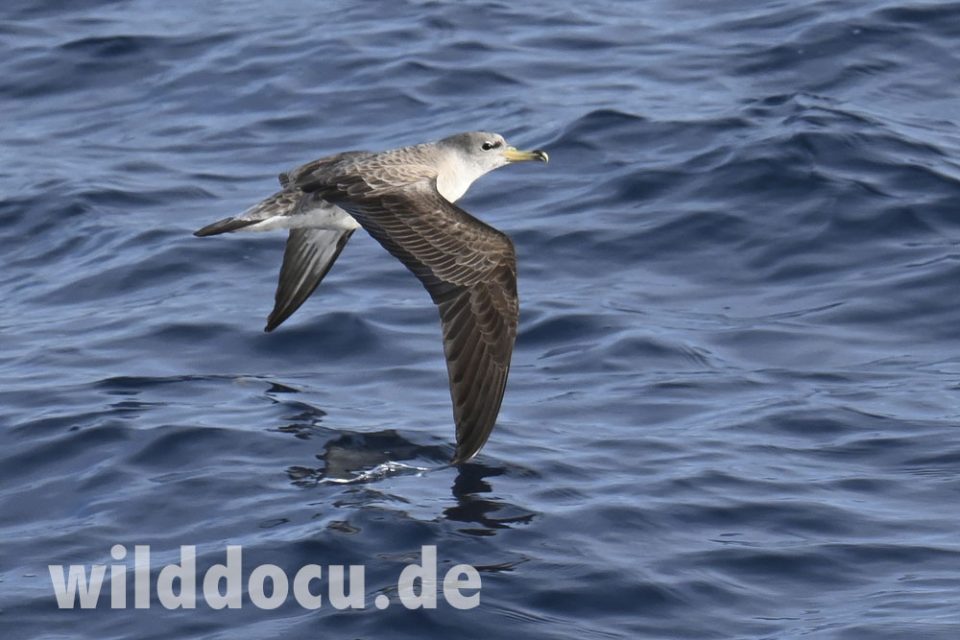
So now we know what it means to search for the “world’s rarest pinniped species” in Greece. We did not find it on this trip, but at least I have a better understanding of the region and the distribution of the species and I know that it is worth to come again.
Sources
G. Hernandez-Milian et al. (2023): “ Monk seal faeces as a non-invasive technique to monitor the incidence of ingested microplastics and potential presence of plastic additives. Marine Pollution Bulletin 193 (2023) 115227
Karamanlidis, A.A. et al. (2016): „The Mediterranean monk seal Monachus monachus: status, biology, threats, and conservation priorities“. Mammal Review. 46 (2): 92–105.


Annie
I enjoyed reading your adventures, and your photos brought back many memories. Thank you. I have not seen a Monk Seal in Greece either, but I did not do the boat trips.
Ralf Bürglin
Thank you, Annie! It seems we share the same passion. I also enjoyed browsing through your websites.
Peter Omejc
Thank you for a very interesting report and photos. I was lucky enough to see one monk seal near Saria in 2020, but that was the only occasion, even though I visit the island every year.
It really is just a matter of pure luck.
Ralf Bürglin
Thank you, Peter! I wouldn’t say it is „pure luck“. You have to be lucky, yes. But with some systematic effort you will find it – sooner or later.
Rithika
So glad to come across SOME report of wildlife in Greece! Really enjoyed reading this. My partner and I are travelling from India next month and are hoping to catch a glimpse of the MMS in Lichadonisia.